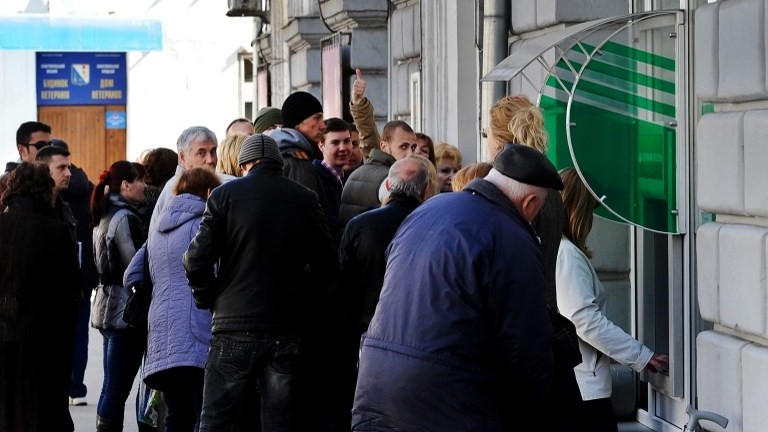
Russia Forces Crimea to Switch From Hryvna to Ruble Ahead of Schedule
Publication: Eurasia Daily Monitor Volume: 11 Issue: 97
By:

Amongst the many complexities of integrating Crimea into Russia, problems regarding the currency and the scheduling of local elections remain at the top. On May 14, the lower house of the Russian parliament (the State Duma) adopted a resolution officially scheduling the local legislative elections in Crimea and the municipal council elections in Sevastopol for September 14, 2014 (ITAR-TASS, May 16). But parliamentary debates on this bill were accompanied by decisions regarding the currency in use on the annexed peninsula—specifically limiting the time the Ukrainian hryvna is legal tender in Crimea to June 1 of this year (https://www.ng.ru/politics/2014-05-13/3_crimea.html). The substitution of the Russian ruble for the hryvna is an extremely complex issue made worse by vacillation on the part of Moscow and its repeated attempts to speed up its introduction.
Originally, the ruble and the hryvna were to exist as co-currencies in Crimea until 2016, although the ruble was supposed to be the main currency in which all wages and benefits were paid (https://kerch.fm/2014/03/24/v-krymu-s-segodnyashnego-dnya-rubl-oficalnaya-valyuta.html). However, President Vladimir Putin mentioned in April 2014 the need to speed up the introduction of the ruble as the sole currency in Crimea due to the threat of default in Ukraine (https://lenta.ru/news/2014/04/18/ruble/). While the threat of default was the official reason, there may be other motives driving the action, such as punishing Kyiv for cutting off the flow of fresh water to the region (Crimea depends on mainland Ukraine for over 80 percent of its water) (ITAR-TASS, April 26). The speed of change became clear when it was announced that after June 1, 2014, only payments in rubles would be accepted, although people could still exchange their hryvna for rubles in banks until January 1, 2016 (https://union.ua/news/economy/s_1_iyunya_ukrainskuyu_valyutu_v_krymu_prinimat_ne_budut/). The historical experience of introducing new currencies, such as with the euro or the German mark after Germany’s re-unification, shows that success is best ensured by a long period of planning. Russia’s extreme hurry suggests that Moscow has an ulterior motive for the ruble’s speedy introduction, such as the desire to present a fait accompli on the ground on the Black Sea peninsula before opening any meaningful negotiations with the West.
Regardless, there are already a number of problems associated with the accession of the Republic of Crimea and the City of Sevastopol to the Russian Federation’s ruble zone. First, some argue that Crimeans are more familiar with using the hryvna and so prefer to pay for goods in that currency. Indeed, some supermarkets only price their goods in hryvna, so there are costs for individuals associated with the change. Other infrastructural problems also persist: with the introduction of the new currency, ATMs will have to be refitted to dispense rubles, and the approximately 2 million people of Crimea will all be trying to change their money at the same time. Indeed, Andrei Klimenko, an associate professor at the Higher School of Economics in Moscow and the chair of the board on regional economies, said that “the fact of the matter was that those three or four Russian banks that were already in the Crimea were physically unable to cope with the situation and were unable to open up tens of thousands of accounts.” Klimenko also noted problems with an increase in prices: “Just a few days ago, the [Russian federal] minister for Crimea [Oleg Savelyev] said that if [the peninsula fully severs] ties with Ukraine, the price of foodstuffs will rise sharply and, consequently, Ukrainian suppliers of foodstuffs, medicines and industrial products will need to deal with a foreign currency… And they do not need that headache, so they will simply refuse to do business with the Crimea” (ru.krymr.com, May 12). The flood of rubles to Crimea in the last two months has already led to an increase in food prices and a projected decline in consumer spending in Crimea.
The bill officially joining Crimea and Sevastopol to Russia was passed by the Russian parliament on March 20 and consists of 24 articles laying out the obligations of Crimea as a constituent republic in the Russian Federation as well as its responsibilities. For instance, the legislation names three official languages for Crimea: Russian, Ukrainian and Crimean Tatar (https://news.allcrimea.net/news/2014/3/20/polnyi-tekst-zakona-o-prisoedinenii-kryma-i-sevastopolya-k-rossii-7924/). However, the legal plan for annexation glosses over the many practical difficulties of integrating these Ukrainian territories into Russia. Numerous observers have noted that the cost of bringing Crimean infrastructure up to date is going to cause problems for Russia, which now finds it difficult to borrow currency on world exchanges. The first signs of this have already started to materialize. On May 13, the head of the Russian Ministry for Economic Development, Alexei Ulyuksev, decided to defund two projects elsewhere in the Russian Federation—one, a bridge in the Far East republic of Sakha (Yakutia), and the other, the development of a cargo port in Krasnodar Krai—partially in order to pay the costs of refurbishing Crimea’s infrastructure. Minister Ulyuksev defended the decision on the grounds that there was “little traffic” in the case of the Yakut bridge and that the development of a port in Taman (Krasnodar Krai) was not needed due to the recent annexation of Crimea (https://www.ng.ru/economics/2014-05-14/4_taman.html).
Thus, the addition of another region to the Russian Federation may prove more contentious for Russia’s internal politics than perhaps anticipated by the Kremlin. In a worst-case scenario, the competition between Russian regions for federal funds could provoke a constitutional crisis similar to what was seen in the early 1990s, prior to the adoption of the 1993 constitution (Daniel S. Treisman, “Russia’s ‘Ethnic Revival:’ The Separatist Activism of Regional Leaders in a Postcommunist Order,” 1997). One way or another, the unforeseen costs for Moscow in absorbing the Crimean peninsula continue to add up.




